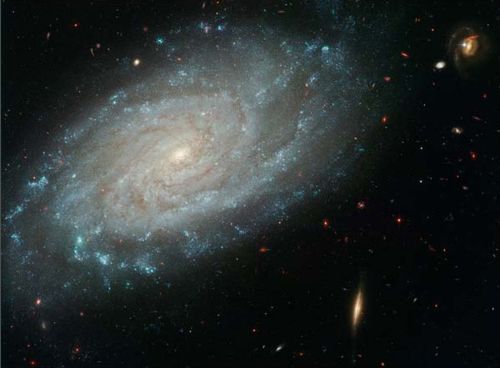The galaxy was photographed in order to find changing stars in it. To do this, the astronomers had to take photographs as close as possible to each other. During the time many photons were collected. The total exposure time in this picture is 24 hours
Avi Blizovsky

Among the backdrop of distant galaxies, the majestic spiral galaxy NGC 3370 shines in the foreground of this new Hubble Space Telescope image. Recent observations by the Space Telescope Survey's Pre-Survey Camera have shown a complex arm where hot regions where new stars are forming have been observed. About ten years ago, a star exploded in the galaxy NGC 3370 and its light overshadowed the rest of the galaxy.
In November 1994, light from a supernova in the galaxy NGC 3370 reached Earth. The explosion of this star shone with a brightness similar to that of the ten billion other stars in its galaxy. Although supernovae are common, with a supernova exploding somewhere in the universe every few seconds, this particular supernova, dubbed SN 1994ae was one of the closest and best to watch since the invention of modern digital detectors. It lies 98 million light-years (30 megafarsecs) from Earth. The supernova is also a special type of supernova, type Ia, the best tool astronomers have to calculate the growth rate of the universe's expansion.
Recently, scientists compared all the nearest type Ia supernovae to the more distant ones and determined that the universe is accelerating its expansion and is full of mysterious "black energy". These measurements are similar to measuring the size of the room by measuring the size of the steps. However, a careful measurement of the leg length (to convert the room size measurement to centimeters) is still needed to know the true size of the room. Similarly, astronomers must calibrate the true brightness of Type Ia supernovae to measure the true size and rate of expansion of the universe.
The nearest Type Ia supernovae like SN 1994ae can calibrate the measurement of distances in the universe, because fainter stars of known brightness are also visible in the same galaxy. These "standard candles" are the variable stars of the cupid type, whose light intensity changes in fixed periods directly related to their essential intensity, and this allows us to know the distance to the galaxy and therefore also to the supernova. However, only the Hubble Space Telescope equipped with the new camera designed for such a survey has the ability to detect individual cupids.
Adam Rice, an astronomer at the Space Telescope Science Center in Maryland, observed the galaxy NGC 3370 dozens of times over a month and saw many cupid variables. Although he and his colleagues can see these Cepheids, they are the most distant that can be observed with Hubble. Because of their need to observe this galaxy more frequently to capture the cupids' variability, the exposure time to observe this galaxy was exceptionally long—almost a full day—and the combined image provides one of the most in-depth views produced with Hubble. As a result, thousands of distant galaxies in the background are visible for the first time.
Dr. Rice photographed NGC 3370 using Hubble in early 2003. His scientific research required observing NGC 3370 with two filters: one in visible light and one in infrared. With the help of the Hubble Heritage Project, a third filter was added to the data to produce the three-color image seen here.
For information on the Space Telescope Scientific Center website
